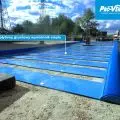Landscape and building environment
We used to think of architectural concrete as a material for vertical elements of facades or interiors. Meanwhile, it also works well as a pavement with a striking texture.
Surfacing architectural concrete
It is a material designed to meet specific appearance requirements. In turn, the purpose and external nature of use impose high expectations for durability parameters. Aesthetics and durability are qualities that are combined in surface concretes with exposed aggregate, i.e. products from the DECO STONE family offered by CEMEX.
Exposed aggregate is an operation that involves removing the cement slurry on the surface of the elements. Thanks to this, DECO STONE pavements get an unusual appearance and texture - the rough surface is anti-slip, it has very good adhesion, and on the other hand, by using selected aggregate and coloring the concrete, an attractive aesthetic effect can be obtained.
As a rule, broken aggregate with a fixed color scheme is used for this type of concrete. For example, light gray granite or black basalt aggregate. Sometimes high-quality gravel aggregate is also used - multicolored, with rounded grain shape.
DECO STONE paving
© CEMEX
Rinsing or hammering
The process of exposing the aggregate can be done in two ways, depending on the desired effect. The first option is rinsing, a process involving the use of surface setting retarders, which are sprayed onto the freshly placed concrete surface. After about 24 hours, the unbound layer of grout is removed, exposing the aggregate and giving the pavement the desired appearance. This operation is carried out using washers.
A slightly different and increasingly popular form of exposing aggregate is hammering, which is the mechanical treatment of already hardened concrete. Unlike flushing, which is done the day after concreting, hammering requires more strength in the concrete, so it is performed after several weeks.
Both methods allow large, monolithic slabs to be made. Expansion lines appearing every few meters give them the characteristics of a large-format surface. Making directly on site eliminates transportation and installation costs, as well as the cost of edging or curbs, which are unnecessary in this technology.
DECO STONE paving
© CEMEX
Why use aggregate exposure? It is not only about visual considerations, but also about durability. The upper surface of concrete elements is the most susceptible to damage from harsh conditions of use - flaking, chipping, non-uniform wear. On the other hand, if this top, weakest layer is removed as early as the execution stage, exposing the aggregate and strong, durable cement matrix, many years of durability and consistent pavement condition are ensured. Both visually and in terms of use.
Where do pavements with exposed aggregate perform best?
DECO STONE pavements have an almost unlimited range of applications. They are suitable both as pedestrian routes and for vehicular traffic. They are used to make sidewalks, alleys, terraces. They work very well in entrance areas to buildings or in recreational spaces: boulevards, squares and plazas.
Learn more
Contact: Marek Dmochowski, tel: 691 393 125
For more information, visit the company's CEMEX Polska Sp. z o.o. page on the A&B portal.





















